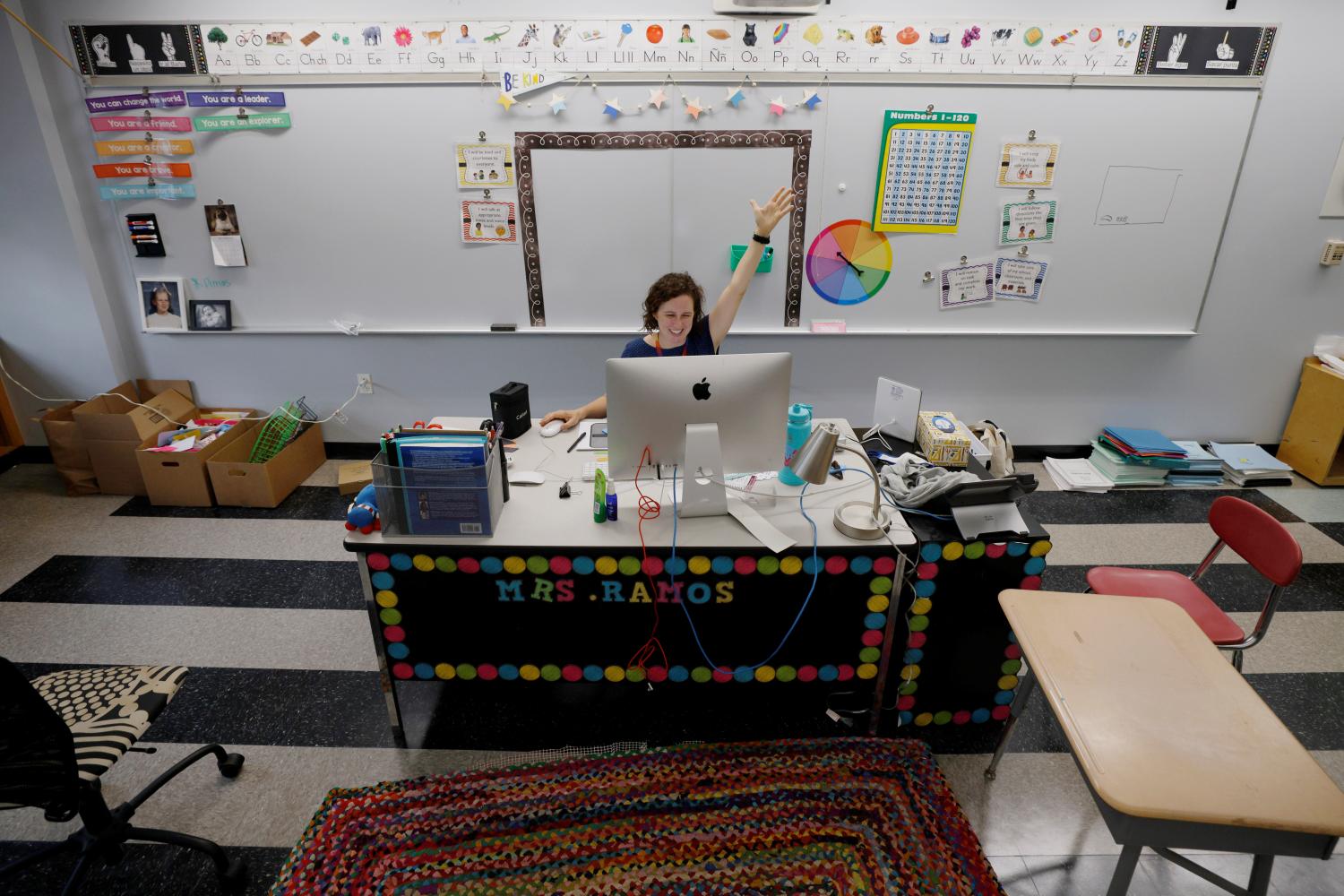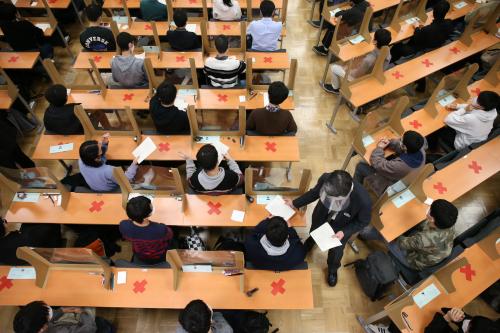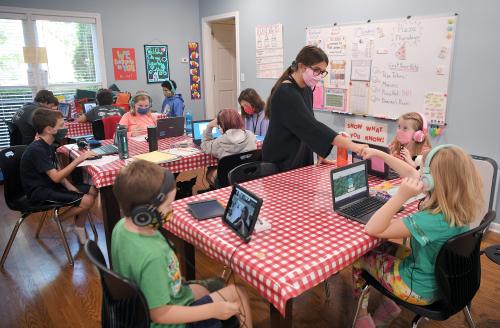While many teachers still endure remote instruction and the Zoom fatigue that comes with it, more and more are returning to schools. Over half the nation’s districts have reopened and children are returning to classrooms, including urban centers like Chicago and New York City—even if they’re peering out from behind plexiglass screens.
But as educators breathe a weary sigh of relief, will they simply snap back to the old normal?
Hopefully not, for this is a poignant moment that should not be wasted. Many teachers are not only weathering the pandemic, they are crafting novel ways of motivating kids and tailoring instruction, even partnering with parents in potent ways. As educators reopen schools, they just might reinvent classrooms.
My research team has followed 32 California teachers since last fall, coding hours of recorded Zoom sessions. It’s clear that many of them feel exhausted after long staring into that flickering grid of bedraggled faces. But we also discovered an uninvited yet living laboratory for creative teachers. Their pedagogical inventions–deploying digital tools that spur lively conversation or offer personalized feedback in real time–have bubbled up from below, rather than mandated by district bureaucrats from above.
Our study also reveals pedagogical breakthroughs that help battle ever widening racial disparities in learning. Inspired teachers now deploy video clips, music, and real-time exercises to invite participation and speak to kids’ colorfully diverse communities. A few innovations stand out: materials and new media that spark robust conversations among students and teachers; digital tools that ease student assessment, then tailor exercises to each student’s proficiency; and rethinking the school day to reduce class size and better organize learning at home.
Lemonade from Lemons
“I hate it,” Antoinette Estrada told me, a fifth-grade teacher outside of Oakland, after months of Zoom-based instruction. But Estrada’s eyes brighten when turning to her novel teaching tools. She moved her entire science curriculum online, hosting “tons of videos relating to what they are reading, with investigations they can do at home.”
Another tool, emulating action-packed video games, invites students to solve math problems, eager to win their digital adventure. This exemplifies a trend in which designers pull the seductive elements of gaming into formal curricula that match state learning standards in clever fashion. Estrada also deploys software that gauges each student’s reading level, then automatically pegs exercises and homework to their proficiency. In short, teachers are discovering the same engaging dynamics inside digital lessons that motivate children to purloin their parent’s cell phone.
Critics often claim that technology breeds impersonal or alienating norms online. But we discovered how digital tools can host safer environs for shy students or those with learning disabilities. “I have kids who participate through chat, but they never talk to me on video,” said Amanda Parker, a Waldorf teacher. Kids with disabilities join mainstream classes in the morning, then break into smaller “intervention groups” during the afternoon.
Creative teachers like Estrada and Parker are not alone, as many educators harvest the fruits of their digital labor. One in every five district chiefs say they will retain digital innovations as their students return, according to a RAND study entitled, “Remote Learning Is Here to Stay.” Nearly three-fourths of the nation’s teachers say one-to-one access to laptops, post-coronavirus, will improve their classroom practices.
Rethinking the School Day
Beyond the move away from didactics, more radical reforms are surfacing as well. Many schools have split classes in half; teachers then repeat new content for tandem groups of just 14 to 16 students. To free morning time for these small classes, asynchronous lectures and written exercises are programmed beforehand, tackled by students in the afternoon.
Parker talks of “reversing” her reopened classroom in which stronger pupils listen independently to taped reading passages, “while I teach the material here with my low kids, and then we flip it.” Some charter networks, like Rocketship Public Schools in Silicon Valley, expect students to watch lectures at home, freeing in-class time for hands-on projects.
Fewer students are marching back to school with sagging backpacks stuffed with textbooks. Teachers have digitized conventional curricula, along with applied exercises, such as art projects and music pieces enlivened electronically. Nor can the dog still eat the homework, since assignments now live online.
Many teachers report housing curricular materials and homework tasks in a single digital location, inviting parents to track their child’s progress and easily lend a hand at home. “I’ve never seen parents so aware of what we are doing day to day,” one teacher told us. Whether these new partnerships with (exhausted) parents can be sustained once kids return to school remains an open question.
Lessons Learned, Policy Leadership
Key lessons have emerged from talking with teachers, along with observing their lessons online. First, novel digital tools best stoke learning in socially cohesive classrooms. Leaders in the ed tech industry talk constantly of personalizing instruction or breeding great autonomy for the lone child. But this narrative ignores how inventive teachers embed digital tools in ways that get all students into the act, stoking kids’ shared interest in math games or story comprehension by blending videos, animation, and digitally energized applications.
Tech-savvy teachers don’t rely on clever digital tools alone, they work from a larger pedagogical toolkit to build socially coherent lessons. They set norms for how children contribute vocally or work on tasks live in unison with one another. Estrada sorts students into breakout rooms where the software reads aloud. Then, kids “explain to each other why they are choosing a certain answer. It’s more interesting doing it together with peers, rather than me talking the whole time,” Estrada said. For more routine tasks, other software magically grades math and vocabulary exercises, freeing her time to devise more challenging activities.
The second lesson from our study: These pedagogical innovations may soon evaporate into thin air, lost amidst repressed memories of the Covid-19 era. Educators display a cathartic joy when returning to their classrooms—now with only a fraction of their kids in attendance, the other half huddled in safe pods down the hall or still sitting at home. But a mindless return to stuffy classrooms will not likely recover kids’ lost year of schooling. This is especially important to remember given that campuses serving higher shares of Black and Latino students have remained closed far longer than those situated in better-off suburbs.
So, can the renaissance in pedagogy, spurred by teachers themselves, somehow be sustained and trumpeted more loudly? Or, will the centuries-old routines of schooling quietly quell these unprecedented digital and social inventions?
Money alone will not be enough. Congress directed $54 billion in fresh stimulus to school districts last December. President Biden aims to more than double this amount, spurring the nation’s momentum in unlocking classrooms. But it remains up to local educators to curate inventive pedagogies that work. We have seen plenty of teaching that fails to engage kids: dreary PowerPoint lectures while students remain dead silent; didactic explication of long division with no opportunity for pupils to practice.
Instead, district leaders might propagate a variety of innovations, from better ways to organize the school day to novel means of engaging parents. Teachers have drawn digital tools and fresh ideas from websites and social media, born instantly out of necessity. But careful research could discern which new pedagogies effectively boost the confidence and competence of all children. Our data stem from teachers in charter schools. Can their peers in large urban districts display this level of creative agility?
Familiar habits and deep-seated rituals must not swamp all that educators have learned over the past year. Instead, teacher associations, district leaders, and policymakers might cultivate these seeds of innovation, nurturing the creative pedagogies that have sprouted across the land.
The Brookings Institution is committed to quality, independence, and impact.
We are supported by a diverse array of funders. In line with our values and policies, each Brookings publication represents the sole views of its author(s).







